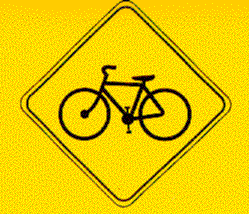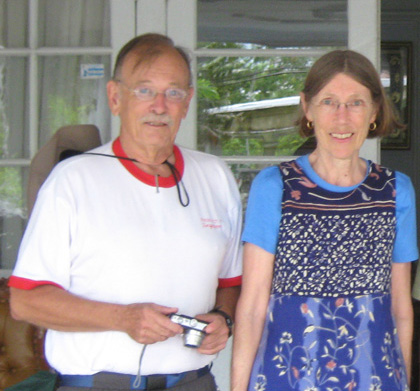
Where Are Ron and Ellen?
Indonesia: 30 November 2010 - 15 March 2011
Ron and Ellen in Bau Bau, Sulawesi, Indonesia
Bau Bau and Pasar Wajo, 27 February - 6 March 2011

To see photos from Bau Bau, click on the thumbnail at the left.
Lunch with Mr. Mayor

To see photos from Pasar Wajo, click on the thumbnail at the left. (Thierry took most of these because Ron was having problems, later solved, with the battery charger for his camera.)
Makassar, Sulawesi, Indonesia
Sunday 6 March 2011Dear Family and Friends,
Last Sunday we and our friend Thierry flew from Makassar to Bau Bau, a city of about 85,000 on Buton Island in Southeast Sulawesi (we have joked, of course, about Bouton visiting Buton). The city is on the eastern side of the island, and stretches along a big curved bay, with hills rising behind it towards the interior. From the esplanade that runs for a few blocks along the harbor area you can see multiple other islands in the bay, all with little towns or villages along their coasts. Small boats travel the bay as ferries between Bau Bau and the various islands. Every evening food vendors set up stalls along the esplanade, and in the large paved area between the esplanade and the road people spread out blankets or tarps to display things for sale - plastic toys, hair ornaments, perfume, hats, etc. Last night for the first time there were perhaps 10 different vendors selling shoes, mostly sandals of various types, since that is what most people here wear (hot temperatures, lots of rain, and it is a culture where one removes shoes at the door). The shoes seemed to be a big attraction, since every display had people crowded around it. We wondered if Saturday night is always shoe night for vendors, since we had not seen them any other night, or whether this was a much rarer sales event.
On the steep hill above the town center is the kraton, the ruins of a royal citadel with long 16th century walls spread across the hillside - spectacular views over the bay and the city. Within the walls there are many traditional wooden houses. The main tourist office is there (not a very convenient location - the hill is long and steep and one generally takes a bus or motor scooter to get to the fort). When Thierry was here in November, he met a young woman working there who spoke excellent French, and he had brought her two French magazines, so we went to the tourist office to look for her. She was there, and very pleased with the magazines, and we also met her boss, the head of the tourism department. He is a very enthusiastic person who speaks good English, and he sat us down and quizzed us on what should be done to bring more tourists to Bau Bau. We talked a bit, and then he decided we should meet the mayor of Bau Bau (always referred to as Mr. Mayor) to discuss our suggestions with him. He said he would phone us that evening after he talked to the mayor's office to arrange a time. We walked back to our hotel in the central part of the city - a long walk, but interesting, and much easier going downhill than up.
The next morning the tourism head collected us at our hotel at 11. Thierry rode on the back of his motor scooter, and we went in a motor scooter rickshaw, going what turned out to be maybe 6-8 blocks to the mayor's office complex. We were ushered into an elegant reception room and introduced to the mayor, who does not speak English, so the tourism head acted as translator, something he apparently does routinely when the mayor travels (although we realized after a bit that the mayor does understand a little bit of English). The three of us had discussed the ideas we would suggest: have at least a small tourism information office in the center of town near the ferry dock and the esplanade (staffed by someone who speaks English), teach English and tourism in the schools so people can communicate with tourists (English being the common tourist language) and understand the kind of things tourists want, have maps of the city for tourists showing various attractions (they can be simple, but people will rarely find things without a map and/or without someone who speaks English to tell them), list the various attractions (nearby waterfalls, beaches, etc) and how to get to them, have accommodations at the beaches (the beaches are anywhere from 8-20 km from town, but the only places to stay are in town) - and more things of that nature. They were very appreciative of our suggestions, and the upshot was that we were invited to lunch the next day at Mr. Mayor's villa on the water near one of the beaches. The mayor seems to be a long-range thinker about the region, and is running for governor in the upcoming elections.
After our visit with the mayor, we walked back to our hotel and the esplanade area for lunch. Later in the afternoon, the tourism head came back and took us to a waterfall about 8 km from town, again with Thierry on the back of his motorbike and us in a scooter rickshaw. The waterfall was quite lovely, with water cascading over a huge rock formation into multiple pools dropping down the hillside. From the waterfall we went a very short distance and walked down a path through forest to a tiny crescent beach below. Then back to town, and to the tourism director's house for tea, where we met his wife and the youngest of his three children. From his house we took one of the little public buses back to the town center.
The next day we were picked up in an official car and taken to the villa, a beautiful traditional-style wooden building overlooking the water, with one of the long sandy beaches just below it. A buffet spread of very excellent food! We talked some more about tourism. There are additional buildings going up around the recently completed villa, and it turns out that this is land the mayor bought personally, and the buildings are to be lodging - so he is creating a resort next to the beach. After lunch we talked a bit more, walked around the site to observe, and were then taken back to town. We agreed that, although Thierry and Ron are two of a kind when it comes to meeting locals and developing opportunities for interactions, there must not be very many tourists here for us to have received such a welcome. Indeed, we have seen no other westerners except for an English diver Thierry met one day and a couple we'd met in Bira that we ran into last night.
Thursday morning we took a bus to Pasar Wajo, a coastal town on the other side of the island that Thierry had also visited in November. It is 48 km away over what may be the worst road we've ever been on, good pavement for about 15 km at the Bau Bau end and about 8 km at the Pasar Wajo end, and what is between a mix of broken pavement, no pavement, huge holes, big ridges, ruts, etc., going up and down over two ridges and through small villages. The trip takes 2 hours. Pasar Wajo is much smaller than Bau Bau, but is also stretched for a long distance along the shore with steep hills behind it. If Bau Bau sees few tourists, Pasar Wajo sees none, although some of the diving cruises stop at diving sites in the bay. In November Thierry had met Arlun, a young man from Pasar Wajo (he was at the internet cafe in Bau Bau because there is no internet in Pasar Wajo) who speaks excellent English. We had told him we were coming, and he met us when we arrived at our hotel that afternoon. Arlun's brother-in-law is running for governor of the region (different region from Bau Bau) - we somehow seem to have hooked up with political candidates! He had borrowed a scooter from a friend, so Thierry and Ron went on that scooter and I rode with Arlun for a tour of the town, and then for dinner, a very excellent fish soup that is a specialty of the area. At Thierry's request, Arlun had arranged to rent a car with driver for the next day, and we all went up the coast road to the north of the city, through many small villages, to a village where houses are built on poles over the water, and through an extensive area of chocolate and cashew trees. The cashew harvest was over, so there were none on the trees, but many of the chocolate trees had fruit on them. The fruit is about the size of a big mango but with ridged skin. When you break it open it is filled with seeds that have a sweet pulp around them - tasty, but nary a hint of chocolate flavor. We were told that the seeds with pulp are fermented and then dried, and then shipped elsewhere for processing. We certainly have seen no local chocolate for sale anywhere. Although coffee is also grown in Sulawesi, we are told that also is shipped elsewhere for processing, and the only coffee we've seen anywhere is finely ground; people put it in a cup and pour hot water over it, leaving grounds in the bottom of the cup when finished. A good bit of the road for our day trip was also pretty rough, although not quite as bad as the road between Bau Bau and Pasar Wajo. By the time we made the trip back to Bau Bau yesterday, we were thoroughly tired of being bounced and jounced!
This afternoon we flew back to Makassar from Bau Bau, and tomorrow we plan to go back to Bira for about 4 days, since we liked it there so much and Thierry has not been there.
Love to all,
Ellen and Ron
Back to the Indonesia 2010-2011 index
Forward to our final week in Bira and Makassar
Back to the Main Index
cfw.com
Questions? Send email to Ellen, ebouton 
operamail.com
While we're traveling, reach us at bikepacker 
Last updated: 28 March 2011
